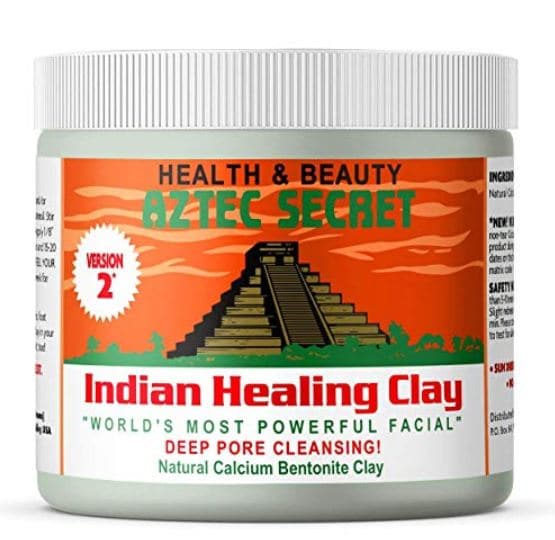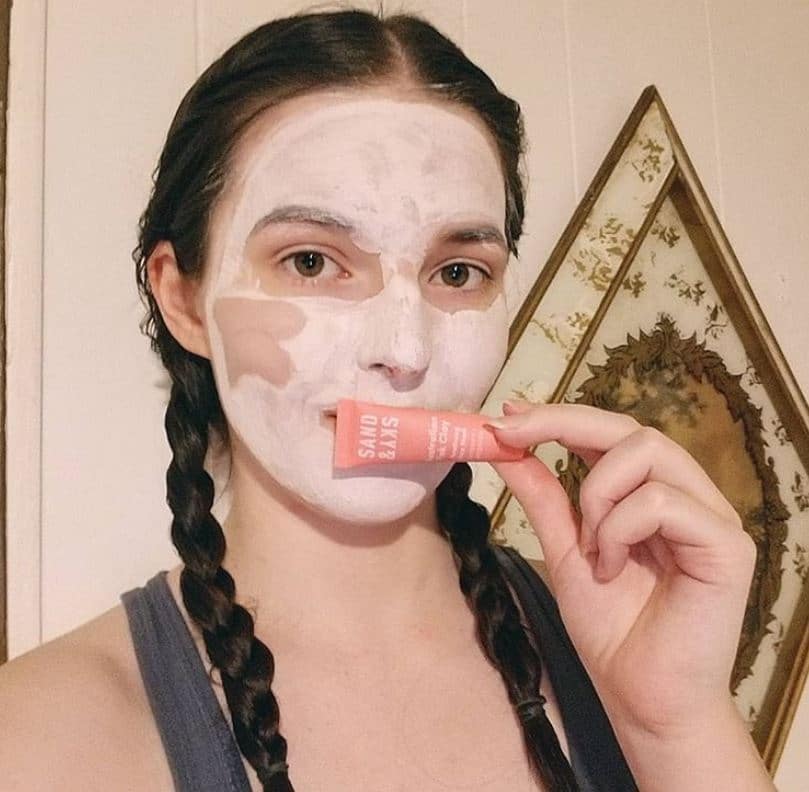
There’s a rainbow of clay options out there, but which clay is the best of the best? I’m going to break down each of the clays you will most commonly see used in face mask products (Spoiler! They’re all pretty much the same…..).
This post contains affiliate links; if you snag a deal through my link it will send some spare change my way to keep this slice of the internet up and running.
Bentonite Clay Face Mask
Let’s start off with one of the most popular clays, bentonite clay! Bentonite is created from volcanic ash. It has strong oil-absorbing abilities which makes it awesome for treating oily skin types. You’ve probably seen bentonite clay sold by the brand Aztec Secret. A face mask recipe using their bentonite clay and apple cider vinegar went viral a few years back because the mixture would “pulsate” on your skin as it dried.

Bentonite has been proven to speed up healing for cuts and blemishes and has anti-microbial properties* which is why I love to use it during acne breakouts. ** It has actually been called “Ee Wah Kee” a.k.a the mud that heals by the Native Americans.
What’s the difference between Kaolin and Bentonite?
On the chemical level, kaolin and bentonite clay are quite different. Please see the handy dandy chart below for the exact origin and structure differences: ?
On the cosmetic side of things, I personally do not see any difference between the two clays. They perform almost identically and have the exact same application and results. Kaolin clay is very slightly cheaper to buy in bulk than Bentonite, but you could easily go either way.
Kaolin Clay Face Mask Benefits
White cosmetic clay (a.k.a kaolin clay), is gentler than the previous clays listed here, which means it is lovely for sensitive skin types! If you do not have oily skin, green and bentonite clays can be very drying and overly aggressive. Kaolin is actually used in many mineral makeup products due to its neutral nature. If you’re in the market for kaolin you can buy it in bulk for extremely cheap here.
Green Clay Benefits (a.k.a French or Illite Clay)
French green clay was originally quarry mined from naturally occurring deposits in France but is now sourced from all over the world. Your clay could come from anywhere between Montana and China but is still be marketed as “French”.
Of all the mud masks I’ve done over the years, I’d have to say most of them were French green clay. There’s just something so satisfying about that classic monster of the black lagoon color of clay.
Although it’s not a pretty picture if you have to answer the door while wearing a hearty layer of mud!?

What about Dead Sea Clay Face Masks?
Dead Sea black clay is naturally anti-microbial + anti-inflammatory *, but this quality is found in many other clays as well! Studies have proven that dead sea clay improves skin conditions like psoriasis as well as many other health conditions. **
Dead sea clay is definitely a useful ingredient in skin care products but it’s not quite as magical as advertised. This mud is jam-packed with minerals like magnesium and potassium, but there is currently zero scientific research that shows that these minerals can be absorbed efficiently when applied topically to the skin.*** Just stick to your daily multi-vitamin, and don’t worry about getting vitamins in your weekly face mask.
Many brands heavily dilute dead sea clay with filler ingredients just to have the catchy buzzword “dead sea clay” on the label. If you find a budget-friendly product like this mask (I’m wearing it in the pic below), feel free to try it out! But don’t waste your money on an overpriced mask when you can get identical results from an in-expensive bentonite clay mask!

Is Dead Sea Clay Safe for Acne-Prone Skin?
There is one major con with using dead sea mud, it has extremely high concentrations of sulfates. Sulfates can clog pores, cause acne, and can be drying when used by sensitive or mature skin types. The mask shown above also has kaolin and jojoba oil which made it tolerable for my dry skin. ****

What’s the big deal about Australian pink clay face masks?
Unless you’ve been living under a rock, you will have heard of the cult-favorite Sand & Sky Australian Pink Clay Porefining Face Mask. This mask comes in at a staggering $49 for a measly 2 oz of product. There are other Australian clay masks like Alya Skin that come in a bit cheaper but they’re still double or triple the price of other varieties of facial clay.
So what’s the big deal about Australian clay? Is it really the best clay compared to other (much cheaper) clays? The truth is, Australian clay is just kaolin that’s been sourced from down under. Many skincare products on the market (I’m looking at you Sand & Sky) mix it with other clays like bentonite.
There is literally zero difference in results after use between kaolin sourced from Australian and other kaolin clays. Some Australian clay is naturally pinkish-red depending on its origin source but be aware that many brands use pigments to dye their products pink.

Which clay is best for your skin type?
This all boils down to the fact that there is very little difference between all the various types of clays. There is one small factor to keep in mind, white clay a.k.a kaolin, absorbs slightly less oil than other varieties which makes it gentler on the skin.
The mineral makeup of each clay will vary depending on where it was sourced, but the vast majority of these minerals cannot be absorbed topically so there’s no reason to pick a clay with more mineral content (dead sea clay is chock full of minerals!).
Need help figuring out the right face mask for your skin type? Read my Face Masks for Dummies Guide!
